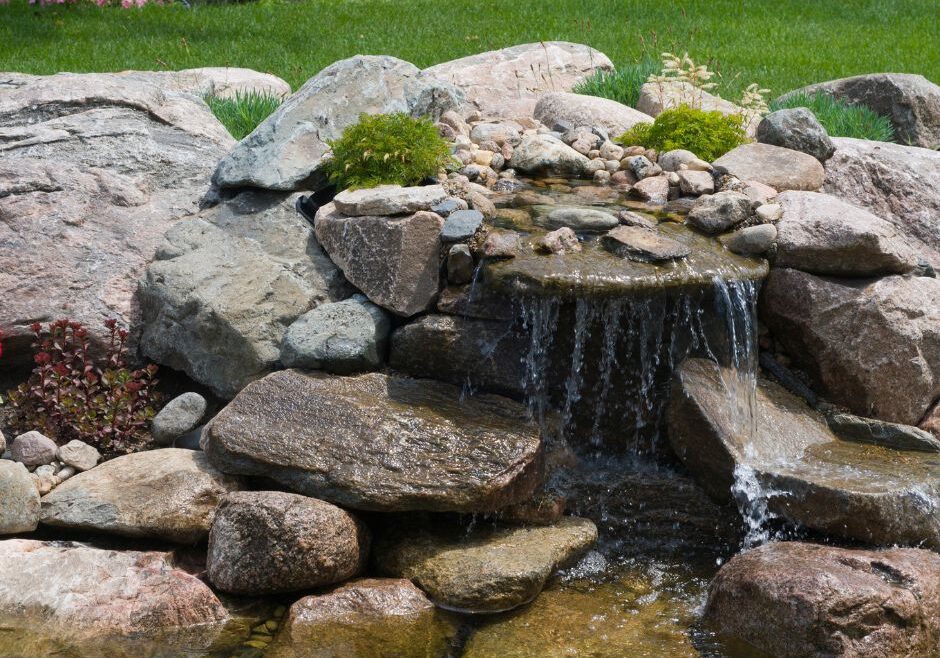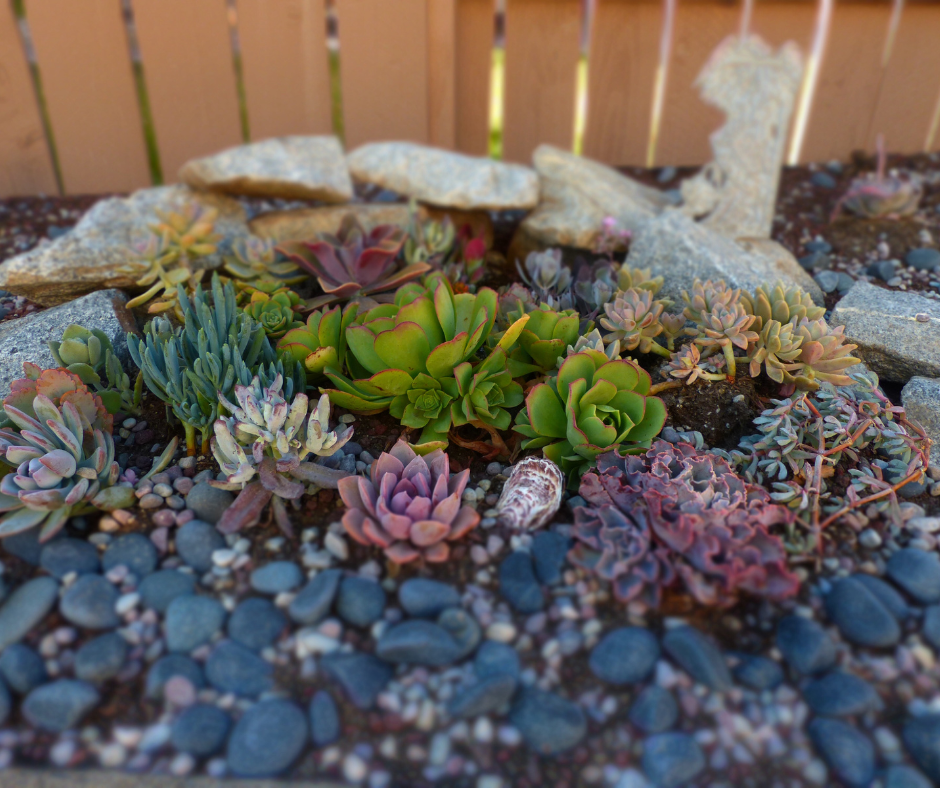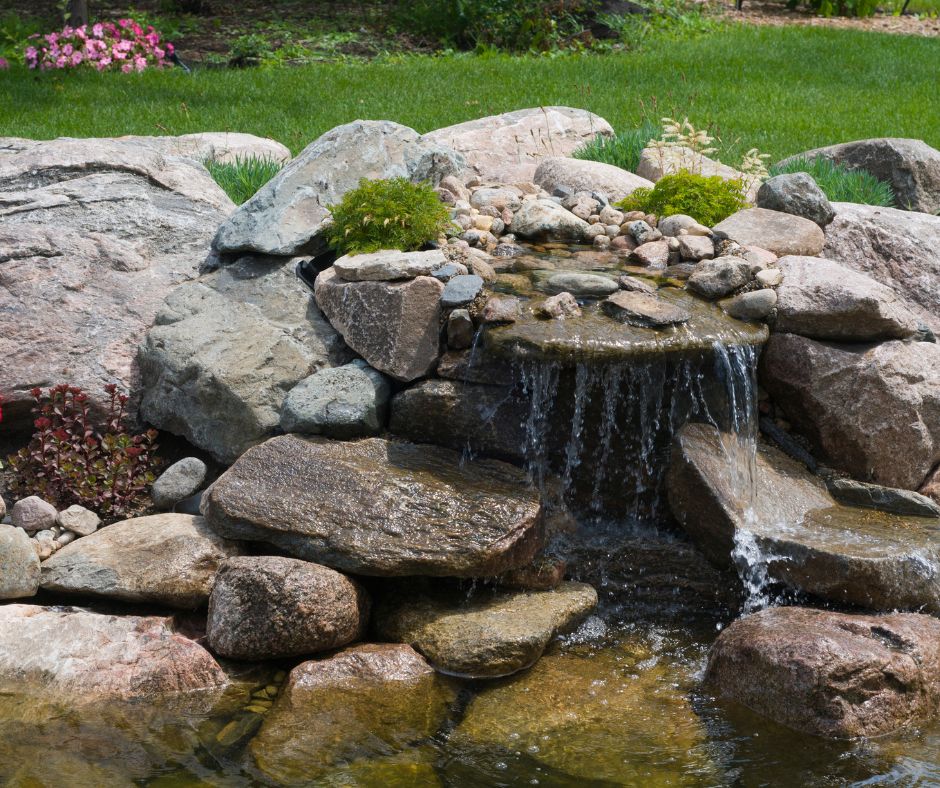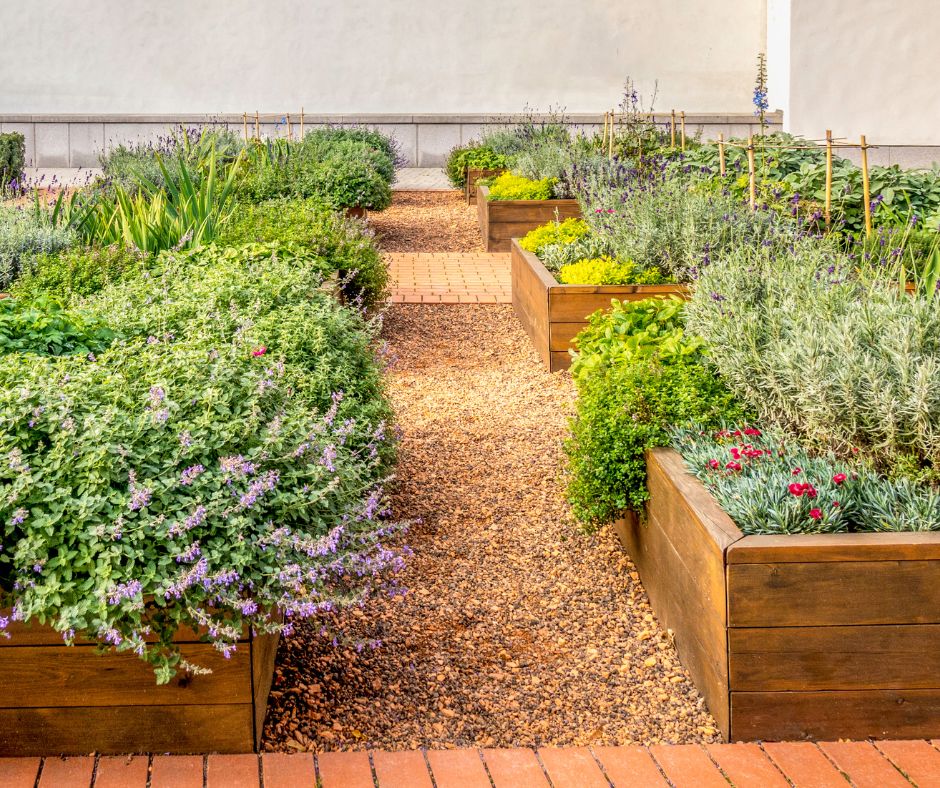The 7 Best No-Grass Backyard Landscaping Ideas for 2024

Style meets sustainability in our list of the top No-Grass Backyard Landscaping Ideas for this year’s outdoor renovations.
In the sunny state of California, where outdoor living spaces are cherished year-round, homeowners are increasingly turning to innovative and water-efficient backyard landscaping ideas. One popular trend that’s gaining traction is the utilization of no grass backyard landscaping ideas, blending functionality, aesthetics, and sustainability. In this article, we’ll explore creative and practical ideas to revamp your backyard, focusing on elements like rock gardens, water features, vegetable gardens, artificial turf, and more.
No-Grass Backyard Landscaping Ideas, For California and Beyond!

1. Rock Gardens:
Incorporating a rock garden into your backyard landscaping not only adds a touch of natural elegance but also embraces the rugged beauty of California’s landscapes. Begin by selecting a variety of rocks in different shapes and sizes, arranging them strategically to create texture and visual interest. Consider using river rocks, boulders, and pebbles to mimic the diverse geology of California. Intersperse the rocks with native plants such as succulents, California poppies, and lavender to infuse color and authenticity into your outdoor space. This combination of rocks and native flora not only provides a stunning focal point but also requires minimal maintenance, making it an ideal choice for a water-wise backyard.
- Zen Rock Garden: Create a tranquil space inspired by Japanese aesthetics, using carefully arranged rocks, raked gravel, and low-maintenance ground covers for simplicity and balance.
- Desert-Inspired Rock Garden: Embrace California’s arid beauty with large boulders, succulents, and cacti. Mimic natural formations and reduce water usage by incorporating sand or gravel as ground cover.
- Cottage-Style Rock Garden: Infuse charm with softer-edged rocks, pastel-colored flowers, and romantic clusters. Include perennial favorites for a delightful, English cottage garden feel.
- Modern and Geometric Rock Garden: Achieve a contemporary look with angular rocks, clean lines, and architectural plants. This style adds sophistication and complements modern design.
- Mediterranean-Inspired Rock Garden: Transport your space to the Mediterranean with warm-toned rocks, aromatic herbs, and terracotta accents. Create a relaxed garden reminiscent of Southern Europe.
- Woodland Rock Garden: Bring the enchantment of a woodland setting to your backyard with natural-looking rocks, moss, and shade-loving plants. Add a winding stone path for a peaceful, forest-like atmosphere.
- Coastal Rock Garden: Capture California’s coastal beauty with smooth, weathered rocks, coastal plants, and seaside accents. Create a meandering path for a seaside promenade feel in your backyard.

2. Water Features That Soothe:
Enhance the tranquility of your backyard by incorporating water features that capture the essence of California’s natural beauty. Consider installing a bubbling fountain surrounded by lush greenery or a small pond adorned with water lilies. For a drought-friendly option, a dry creek bed with river rocks can create a visually appealing and water-wise focal point. These water features not only provide a soothing ambiance but also attract local wildlife, adding to the ecological diversity of your outdoor space.
Some water features that we love to install:
Fountains:
Description: Elegant and classic, fountains come in various styles, such as tiered or wall-mounted. They add visual appeal and soothing sounds to outdoor spaces.
Ponds:
Description: Larger water features that support aquatic life and can include waterfalls. Ponds create a natural environment, attract wildlife, and offer a reflective surface.
Waterfalls:
Description: Dramatic features that add movement and sound to landscapes. Waterfalls can be standalone or integrated into ponds, creating a serene atmosphere.
Streams:
Description: Flowing water features that wind through gardens. Streams, often adorned with rocks and plants, connect different water elements in the landscape.
Reflecting Pools:
Description: Shallow pools that create mirror-like reflections of surrounding elements. Reflecting pools add elegance and serenity to outdoor spaces.
Wall-Mounted Water Features:
Description: Stylish and space-efficient features like water walls or cascading sheets. Ideal for smaller spaces or as decorative elements on patios and walls.
Birdbaths:
Description: Shallow basins attracting birds. Available in various styles and materials, birdbaths contribute to the garden’s ambiance.
Spillways:
Description: Narrow channels guiding water flow, often connecting different levels or containers. Spillways add dynamic and visual appeal to water features.
Rain Chains:
Description: Decorative alternatives to downspouts, guiding rainwater through hanging cups or links. Rain chains add an artistic and melodic element to outdoor spaces.
Water Gardens:
Description: Ecosystems combining aquatic plants, fish, and water features. Water gardens offer aesthetic beauty and a natural balance to outdoor spaces.

3. Vegetable Gardens with Style:
Elevate your backyard with a vegetable garden that not only yields fresh produce but also serves as an aesthetically pleasing element. You may opt for raised beds made from natural materials like stone or composite materials, arranged in different patterns for visual appeal. Choose a variety of drought-tolerant vegetables and herbs, such as tomatoes, peppers, and rosemary, to thrive in the California sun. Incorporate white flowers, like those from zucchini or cauliflower plants, for an ornamental touch. This functional and stylish vegetable garden allows you to enjoy homegrown produce while adding beauty to your backyard.
If you choose to incorporate a vegetable garden, your first major choice may be whether to plant directly into the ground or to build raised garden beds. Here are some thoughts to consider:
Raised Vegetable Beds vs. In-ground Planting
Raised Vegetable Beds:
- Pros:
- Improved Drainage: Raised beds offer excellent drainage, preventing waterlogged soil and promoting healthy root systems.
- Better Soil Control: Gardeners have greater control over the soil composition, allowing for custom blends tailored to specific plant needs.
- Reduced Weeding: Raised beds can minimize weed growth, providing a more manageable and aesthetically pleasing garden.
- Cons:
- Initial Cost: Building or purchasing materials for raised beds may involve an upfront cost.
- Limited Space: The confined space of raised beds can be limiting for sprawling plants or those with extensive root systems.
In-Ground Planting:
- Pros:
- Natural Soil Interaction: Plants in the ground can access a larger volume of soil, promoting natural root development and nutrient absorption.
- Cost-Effective: In-ground planting typically involves fewer expenses initially, especially if your soil quality is already suitable for gardening.
- Space Flexibility: In-ground planting allows for unrestricted growth and is suitable for larger crops or those with expansive root systems.
- Cons:
- Compromised Drainage: In-ground planting may face drainage issues, especially in clay-heavy soils, potentially leading to waterlogged conditions.
- Increased Weeding: Weeds may proliferate more in open soil, necessitating more diligent weeding efforts.
- Soil Quality Challenges: Soil quality can vary, requiring amendments to achieve optimal conditions for certain plants.

4. Artificial Turf for Low Maintenance:
Swap traditional grass lawns for artificial turf to achieve a vibrant, green look without the need for constant maintenance. Artificial grass is an excellent solution for sunny California yards, providing a soft and safe surface for play areas and gatherings. Choose a high-quality artificial turf that mimics the look of natural grass, and enjoy a lush, green lawn throughout the year without the hassle of watering, mowing, or fertilizing. This low-maintenance option not only conserves water but also frees up time for you to relish your outdoor living space.

5. Fire Pits as a Focal Point:
Transform your backyard into a cozy retreat by incorporating a fire pit as a central focal point. Choose natural stone or patio pavers to construct a durable and aesthetically pleasing fire pit. Surround the area with comfortable outdoor furniture, creating an inviting seating area for gatherings. Add extra flair by incorporating native plants and ground covers around the fire pit to seamlessly blend it with the natural surroundings. This focal point not only enhances the visual appeal of your outdoor space but also provides a warm and inviting atmosphere for year-round enjoyment.
Check out our post on backyard fire pits for some more inspiration!
6. Native Plants for Sustainability:
Integrating native plants into your landscape design is a sustainable and visually appealing choice for a California backyard. Select plants that are adapted to the local climate, requiring less water and maintenance. Consider incorporating California native species like ceanothus, manzanita, and California sagebrush. Group plants with similar water needs together to create efficient irrigation zones. This approach not only conserves water but also fosters a thriving ecosystem with native flora, attracting butterflies, bees, and other beneficial pollinators to your garden.
Some California Native Plants to Consider for Your Backyard:
California Poppy (Eschscholzia californica):
- Description: The iconic golden-orange flowers of the California Poppy make it a symbol of the state. It thrives in full sun and well-drained soil.
Manzanita (Arctostaphylos):
- Description: Manzanitas are evergreen shrubs or small trees with attractive, smooth bark and delicate, urn-shaped flowers. They are well-adapted to California’s diverse climates.
Lavender (Lavandula):
- Description: Several varieties of lavender are well-suited to California’s Mediterranean climate. They offer fragrant foliage and attract pollinators.
California Lilac (Ceanothus):
- Description: Known for their vibrant blue to lilac-colored flowers, California Lilacs are versatile shrubs that thrive in dry conditions and are a favorite in native landscaping.
Salvia (*Salvia spp.):
- Description: Various Salvia species, such as Cleveland Sage (Salvia clevelandii), offer drought-tolerant options with aromatic leaves and spikes of colorful flowers.
Matilija Poppy (Romneya coulteri):
- Description: This large perennial, also known as the “fried egg plant,” produces large, showy white flowers with a distinctive appearance. It’s well-suited to sunny locations.
California Buckwheat (Eriogonum):
- Description: California Buckwheats are drought-tolerant, low-maintenance plants with clusters of small, often pinkish flowers. They attract pollinators and add texture to landscapes.
Toyon (Heteromeles):
- Description: Also known as California Holly, Toyon is an evergreen shrub with glossy, serrated leaves and clusters of bright red berries. It’s often used for hedging.
Douglas Iris (Iris douglasiana):
- Description: This native iris species offers elegant, violet-blue flowers and is well-suited for shaded or partially shaded areas in California gardens.
Yarrow (Achillea millefolium):
- Description: Yarrow is a versatile and hardy perennial with feathery foliage and flat-topped clusters of flowers. It comes in various colors and attracts pollinators.
Utilizing these California native plants in landscaping not only enhances the aesthetic appeal of your outdoor space but also promotes biodiversity and supports the ecological balance of the region. Our experts can help advise you as to which native plants would be best suited to your individual landscaping project. Reach out to us for any help you need with no grass backyard landscaping ideas.
7. Ground Covers and Low-Maintenance Options:
Minimize the need for extensive lawn maintenance by incorporating ground covers that not only add texture but also serve practical purposes. Wood chips, pea gravel, and natural or synthetic mulch can be strategically placed in various areas to create defined pathways, play areas, and seating spaces. Use ground covers around flower beds and trees to suppress weeds and retain moisture. The aesthetic appeal of these low-maintenance options extends to high-traffic areas, providing a visually pleasing and functional solution for small spaces, ensuring that your backyard remains both beautiful and manageable.
Living ground covers are also a great option for many backyards. In California, where water conservation is often a priority, choosing drought-tolerant ground covers is particularly important. Here are some popular living ground cover options suited for California landscapes:
Ice Plant (Delosperma):
- Description: Ice plants are succulent ground covers with vibrant, daisy-like flowers. They are excellent for erosion control and thrive in full sun, making them suitable for various California climates.
Creeping Jenny (Lysimachia nummularia):
- Description: With its cascading foliage, Creeping Jenny is an excellent ground cover for moist areas. It adds a touch of brightness with its chartreuse leaves and is well-suited to partial shade.
Dymondia (Dymondia margaretae):
- Description: Dymondia is a low-growing, grass-like ground cover that forms a dense mat. It is drought-tolerant and ideal for sunny areas, providing an attractive alternative to traditional turf.
Trailing Lantana (Lantana montevidensis):
- Description: Trailing Lantana is a fast-spreading ground cover with aromatic foliage and clusters of colorful flowers. It thrives in full sun and attracts butterflies, making it a lively addition to the landscape.
Thyme (Thymus):
- Description: Thyme varieties, such as Creeping Thyme, are aromatic, low-growing ground covers with tiny, colorful flowers. They are well-adapted to sunny locations and are drought-tolerant once established.
Ajuga (Ajuga reptans):
- Description: Ajuga, also known as Bugleweed, forms a dense mat of colorful foliage and spikes of small flowers. It’s adaptable to various light conditions and adds texture to the landscape.
Kurapia (Lippia nodiflora):
- Description: Kurapia is a low-maintenance ground cover that tolerates foot traffic well. It has a spreading habit, lush green foliage, and is drought-tolerant, making it suitable for sunny areas.
Santa Barbara Daisy (Erigeron karvinskianus):
- Description: This charming ground cover features daisy-like flowers that change color as they age. Santa Barbara Daisy is drought-tolerant and attracts pollinators, making it a delightful addition to gardens.
Red Apple Ground Cover (Aptosimum):
- Description: With its bright green leaves and vivid red flowers, Red Apple Ground Cover is eye-catching and drought-tolerant. It’s well-suited to sunny locations and slopes.
Blue Star Creeper (Pratia pedunculata):
- Description: Blue Star Creeper forms a carpet of tiny, star-shaped flowers and bright green foliage. It’s well-suited for shaded areas and is a great alternative to traditional turf in small spaces.
When choosing ground covers for your California landscape, consider factors such as sunlight exposure, water requirements, and the specific conditions of your garden. A well-thought-out selection of ground covers can contribute to the overall beauty and sustainability of your outdoor space.
Use these No-Grass Backyard Landscaping Ideas to make the most of your outdoor space this year!
By implementing these no grass backyard landscaping ideas, you can create a stunning and sustainable outdoor space that embodies the beauty and spirit of California. From rock gardens and water features to artificial turf and native plants, each element contributes to a harmonious landscape that requires less maintenance, conserves water, and reflects your personal style. Transform your California backyard into a haven where you can relax, entertain, and connect with nature for years to come.



